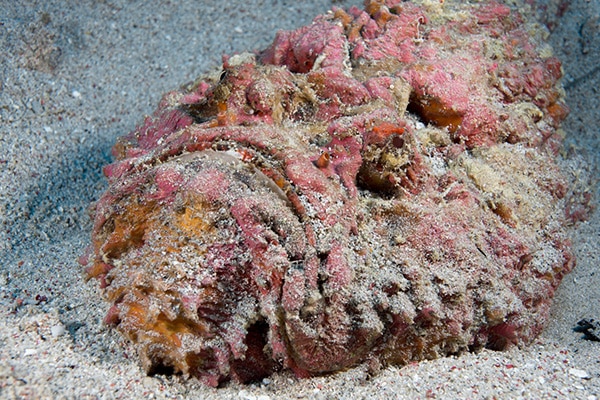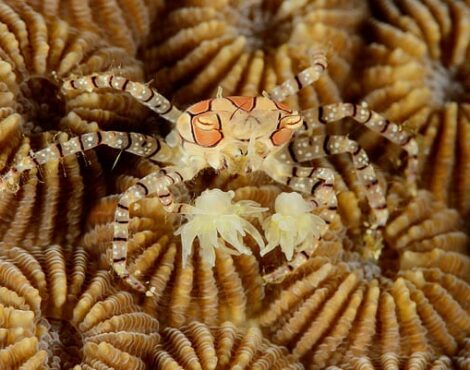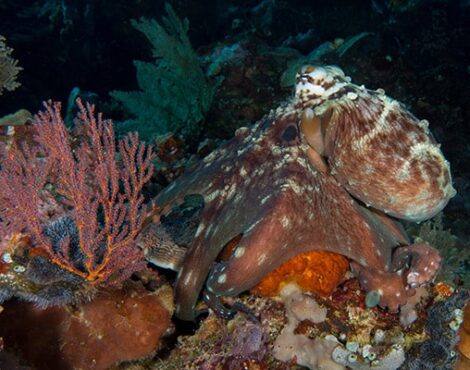The deep waters that run through Bunaken Marine Park are hiding a lot â there are almost certainly species living here that we still know nothing about.
But itâs not just the deep water that is hiding things â the shallows are home to many cryptic animals that are hiding in plain sight. Today, we are going to talk about one such species, the reef stonefish.
What are Stonefish?
Found in coastal regions of the Indo-Pacific, stonefish are actually a family of venomous fish, although for most people, the name stonefish refers to one species in particular â the Synanceia verrucos, or reef stonefish.
They are a member of the order Scorpaeniformes, which includes other well-known venomous fish such as scorpionfish and lionfish, and as such, stonefish share many similarities with them.
How can I identify a Stonefish?
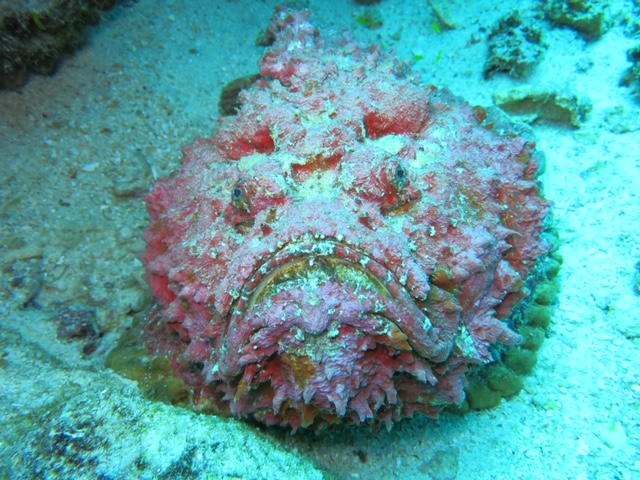
Photo by John Madsen
Growing to over 40cm in length, the reef stonefish is quite large for a bottom dwelling critter, but despite its size, spotting one is not easy. As the name implies, stonefish look rather similar to a stone or a rock â even when pointing directly at it, it is not uncommon for others to not realise what they are seeing.
The biggest giveaway is the large, upturned mouth (somewhat similar to that of a stargazer) â which is also the easiest way to tell them apart from larger, more cryptic species of scorpionfish. Their eyes are also often a giveaway, as they are slightly raised from the rest of the head. This is because they often dig themselves slightly into the sand to further hide them, and having raised eyes allows them to keep watch for any potential prey.
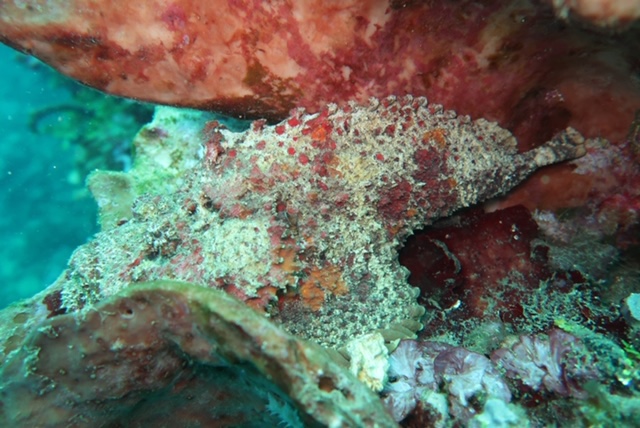
Photo by John Madsen
Their colour can vary wildly between different individuals, from dull grey or brown, to orange, purple, pink, or red (or any combination of the above). These brighter colours actually add to the camouflage, as the shades tend to be very close to that of certain algae that grow on rocks and dead coral. To further improve their camouflage, they often have what appear to be growths over their body â appearing even more stone like than before.
It is very unusual to see a stonefish swim. They tend to be resting on the seabed or coral reef, waiting for any unsuspecting small fish to pass by.
What do Stonefish eat?
Like closely related scorpionfish and lionfish, reef stonefish are carnivores and ambush predators.
This means they eat a diet that consists entirely of other animals, and for the reef stonefish, this means small fish, shrimp, and other small crustaceans.
As ambush predators, they wait in one place until their food comes to them. Unlike frogfish, stonefish donât have any way to attract their prey to them, so they must remain patiently on the seabed (still as a rock?) until something comes within range.
Their camouflage is extremely convincing, however they are not fast swimmers, so they must wait until the prey is very close before making a lunging strike.
Stonefish venom
Like scorpionfish and lionfish, stonefish are well known for their potent venom.
The reef stonefish is the most venomous fish on the planet, and it is one of the few fish who possesses venom powerful enough to be lethal to humans â with the elderly, children, or those with weak immune systems being most at risk.
The venom is located in fishâs 13 dorsal spines, each of which has two venom sacs. Stonefish cannot use these spines as weapons, however they are extremely effective for defence purposes. The spines are extremely stiff and sharp, even being strong enough to penetrate boot soles.
If stung, the effects of the venom will begin almost immediately. The victim will feel severe pain, shock, extreme nausea, and localised tissue death. The immediate first aid response is immerse the affected area in hot water (up to 45 degrees, or as hot as the victim can stand), as the heat will denature the proteins in the venom. Medical care is highly recommended with stonefish stings, as a local anaesthetic can help relieve pain, and only trained medical professionals can administer the anti-venom â although this is only necessary in severe cases.
Where can I see a Stonefish?
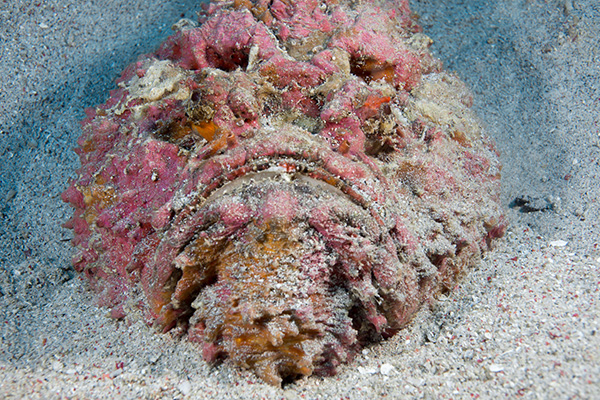
Despite their potentially dangerous nature, stonefish are a popular sighting among divers and snorkellers. Because of their amazing camouflage, spotting one is extremely rewarding, and as they are quite large, you donât need superhuman vision to see it.
Stonefish can be found throughout Bunaken Marine Park, and tend to be spotted shallower that 20 metres. The often sit on rubble patches near the reef top or slope, so snorkellers have just as good a chance of seeing them as divers do.
We frequently see them on the North Sulawesi mainland, however there doesnât seem to be any site that is better than another for finding one â be it black sand muck diving, or beautiful coral slope. As with any fish, a lot of it comes down to paying attention to every nook, cranny, and rock. Of course, luck has a lot to do with it too.
Stonefish Safety!
We saved the most important bit until last.
Stonefish have venom powerful enough to kill, but by following a few simple tips, we can ensure that your stonefish encounter will be a memorable one (for the right reasons).
Snorkellers, swimmers, and those paddling in the shallows should pay extra care where they walk in the sea, as stonefish can be found as shallow as one metre. Never walk over seagrass, as they often use this to further their camouflage. Booties are highly recommended while wading through the shallows, and always take cautious, light steps (it is suggested that stonefish inject an amount of venom that is proportionate to the pressure applied to the spines.)
Divers should always take care when near the seabed. Should you want to rest on the sand while trying to take a picture, ensure that the area below you is clear, and remember that stonefish can cover themselves in sand, but the eyes will always be visible. Never touch anything underwater, even rocks â because as we know, it could be a highly venomous fish…

